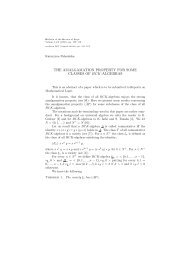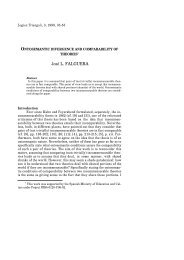ON THE LOGIC OF ADVERBS
ON THE LOGIC OF ADVERBS
ON THE LOGIC OF ADVERBS
Create successful ePaper yourself
Turn your PDF publications into a flip-book with our unique Google optimized e-Paper software.
Bulletin of the Section of LogicVolume 11:1/2 (1982), pp. 62–63reedition 2009 [original edition, pp. 62–64]Ingmar Pörn<strong>ON</strong> <strong>THE</strong> <strong>LOGIC</strong> <strong>OF</strong> <strong>ADVERBS</strong>In this paper I investigate adverbial modification as an operation applyingan adverb or adverbial phrase to a predicate and thereby creatinga new predicate. To this end I define languages determined by a set P redof simple predicates, a system Mod of predicate modifiers, and a class Xof individual constants. If L(P red, Mod, X) is such a language, it employsthe symbols that determine it and, in addition, the following symbols:⊃, f; ∩, ′ ; ∀; individual variables; and punctuation symbols. The class ofpredicates of L(P red, Mod, X) id defined recursively in the following way:(1) Base = P red.(2) If P is an n-place predicate so is P ′ .(3) If P is an m-place predicate and Q and n-place predicate then (P ∩Q)is a max(m, n)-place predicate.(4) If P is an n-place predicate and K an n-place predicate modifier thenK(P ) is an n-place predicate.(5) Restriction.In accordance with (4), e.g. “slowly” in “John walks slowly” is classedas a monadic predicate modifier; “slowly” in “John approaches Jane slowly”is classed as a dyadic predicate modifier, and so on.The class of wffs of L(P red, Mod, X) is defined in the way in whichit is usually done in first-order languages and the abbreviations customaryin such languages and in Boolean set algebra are introduced.A model of type < P red, Mod > is a structure M = < X, V > whereV is a function defined thus:(1) If P is an n-place predicate in P red then V (P ) ⊆ X n .(2) If P is an n-place predicate then V (P ′ ) = X n − V (P ).
On the Logic of Adverbs 63(3) V (P m ∩ Q n ) = V (P m ) ∩ V (Q n ) = the set of all sequences (x 1 , x 2 , . . .,x max(m,n) ) such that (x 1 , x 2 , . . . , x m ) ∈ V (P m ) and (x 1 , x 2 , . . . , x n ) ∈V (Q n ).(4) If K is an n-place predicate modifier then V (K) is a choice functionon X n .Note on (4). As per [1], a choice structure (F, g) on X n is a class F ofsubsets of X n and a function g, defined on F , such thatg(X) ⊆ X for every X ∈ F ;g(X) ≠ ∅;for every X, Y ∈ F , if X ⊆ Y then g(Y ) ∩ X = ∅ org(Y ) ∩ X = g(X).A choice function on X n is the function g of some choice structure onX n .The relation |= between models and sentences of L(P red, Mod, X) isdefined in the same way as in first-order logic except that the followingcondition is added:M |= K(P n )(a 1 , a 2 , . . . , a n ) iff (a 1 , a 2 , . . . , a n ) ∈ V (K)(V (P n )).Validity is obtained in standard fashion.The system captures such features of adverbial modification as recursiveapplication, deletion, permutation, and non-contraction. The system mayeasily be extended in various directions. For example, it may be extendedto include modal operators and, in particular, modal action operators. Thisextension is relevant in the discussion of scope problems in the context ofadverbial modification.References[1] Bengt Hansson, Choice Structures and Preference Relations, Synthese18 (1968), pp. 443–458.Department of PhilosophyUniversity of Helsinki






